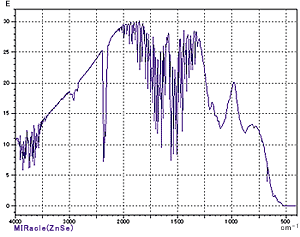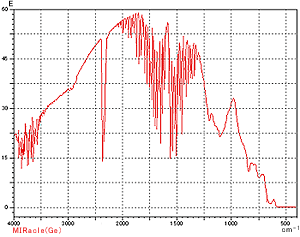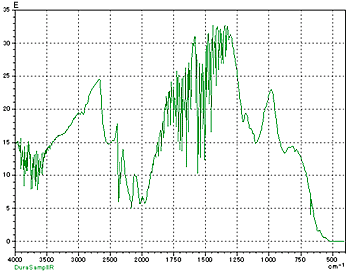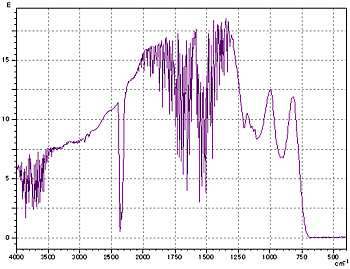How to Read Power Spectra - Part 2 - Checking Power Spectra
The shape of a power spectrum differs according to the window material and optics system in the accessories used for measurements and according to the type of detector used. The measurement environment also has a major influence due to superimposition of noise components from water vapor and carbon dioxide gas, for example. Therefore, the features of the power spectrum must be thoroughly investigated before starting the measurements.
Now we will measure the power spectra of various accessories.
(1) Single-reflection Attenuated Total Reflection
Attenuated Total Reflection (ATR) measurements are conducted by placing the sample in close contact with the surface of a prism made of highly refractive material that transmits infrared light.
This method permits measurements using chemical pretreatment of the sample, without mechanical machining. Consequently, the number of accessories using this method is increasing as FTIR sensitivity increases.
Fig. 1 and Fig. 2 show the power spectra obtained from a single-reflection attenuated total reflection instrument (product name: MIRacle) with a ZnSe (zinc selenide) prism and Ge (germanium) prism mounted, respectively.
Both ZnSe (zinc serenade) and Ge (germanium) absorb IR at lower wave numbers, such that spectral data cannot be obtained below about 600 cm-1.

Fig. 1 MIRacle Power Spectrum: ZnSe Prism

Fig. 2 MIRacle Power Spectrum: Ge Prism
As the ATR method measures the spectrum of IR light from the prism penetrating the sample, close contact between the sample and prism is extremely important. However, as germanium is relatively soft, with a Knoop hardness number of 24, its surface becomes scratched with use. The scratches cause poor contact with the sample and may result in the prism breaking due to the increased clamping force applied.

Fig. 3 DuraSamplIR-II Power Spectrum
The diamond ATR accessory has diamond on the sample contact surface, which allows the sample to be pressed strongly against the prism surface. This accessory allows the measurement of hard samples that are difficult to measure using conventional ATR.
Fig. 3 shows the power spectrum obtained from a single reflection attenuated total reflection instrument (product name: DuraSamplIR-II) with a ZnSe support element mounted below a diamond prism.
A moderate absorption between 2700 and 1500 cm-1 is observed in Fig. 3. This is the absorption of diamond, which can shift the baseline in this region during measurements of high-refractive-index samples.
(2) Gas Cell, Liquid Cell
An IR-transmissive window is essential to seal in a gas or liquid.
Various window types are used for different sample characteristics. However, it is important to check the quantitation peak positions and the transmission range of the window.
(3) IR Microscope

Fig. 4 Power Spectrum using a 20 µm × 20 µm Aperture Set (AIM-8800 IR Microscope)
An IR microscope is useful for the measurement of minute samples.
Due to the high sensitivity required, an MCT detector is used to measure minute samples with an IR microscope.
As it can detect extremely low throughput of IR light, the MCT detector is suitable for light intensity attenuated measurements such as IR microscope measurements. However its wavelength-sensitivity characteristics offer no sensitivity below the cutoff frequency (wavelength at which sensitivity becomes zero).
Fig. 4 shows the power spectrum measured with an aperture set at 20 µm square.


